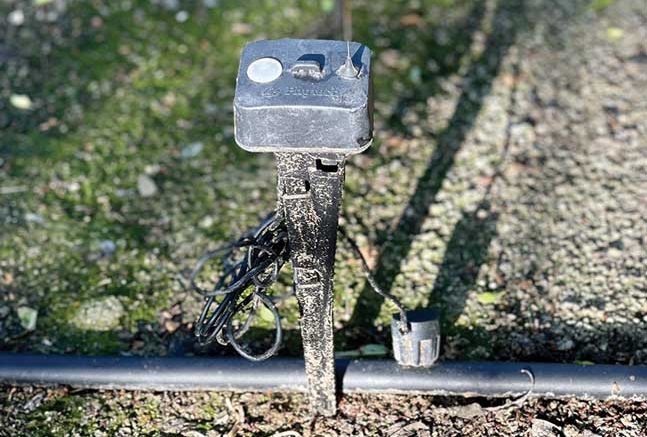|
Click to listen to this article
|
Move from simple data collection to putting data in action
By Sonja Gjerde
- Smart water management saves farmers money and supports agricultural sustainability.
- Tools available today track water usage by field and farm for whole-operation decision making.
- In-field and in-soil technologies help shore up water-use efficiency.
Because California only receives around 21 inches of rainfall annually, growers in the state know how to do a lot with a little. For example, they use irrigation and smart water techniques to ensure orchards, row crops and livestock succeed.
“We have no other choice in California ― being water conscious is a necessity,” says Ethan Nichol, a California independent crop consultant.
Water management from California to Maine and every state in between is complex. It requires data about soil moisture and crop moisture uptake, and information about current and upcoming weather conditions. New technologies are more important than ever when it comes to water management in flood, drip and center-pivot irrigation.
Understand Farm Water Consumption
It’s difficult to measure improvement without benchmarking. Growers must know where fields stand today to measure savings from better water-use efficiency.
“One of the biggest struggles I’ve seen is farmers don’t always know how much water they’re putting down on fields,” says Dayna Gross, sustainability manager of partnership and programs for Syngenta North America. “Step one is increasing monitoring to understand what is actually being put out on the field.”
To understand where your operation stands, USDA’s Sustainable Agriculture Research and Education group recommends the following steps:
- Collect data. Map fields, location of water supply networks, inventory pumping plans, and meters or measuring points. USDA also recommends noting field slope and soil information, including texture, type and infiltration rates. If the field uses irrigation, then document the irrigation method, the schedule, and well construction and testing records.
- Audit the operation. Perform a physical irrigation audit to verify water use by reviewing water- and energy-use efficiency on the farm.
- Create a report. Data collection and audit information will provide evidence needed to generate a report about equipment, irrigation schedules and water uses across the operation. This report will provide practical information, such as when to schedule maintenance and how to improve irrigation systems overall.
“That measurement piece and record keeping are key,” says Steven Wall, sustainability development manager for Syngenta North America. “And new tools can help you understand soil moisture and plant health so you can use all of this information to get the right amount of water to the plant at the right growth stage.”
Use Technology to Inform Decisions
The days of walking fields to check for moisture stress aren’t over yet, as soil probes are still widely used, but certain tools help focus scouting efforts. From satellites and drones to stationary soil monitors and plant-sensing technologies, growers can increasingly turn information into action.
“Remote sensing is a great tool, and imagery is a great way to get a feel for how crops are doing,” Wall says. “Aerial imagery is one way to see discoloration or other indicators of plant stress.”
Seed and agronomy companies are taking note. Syngenta, for example, launched the Water+™ Intelligent Irrigation Platform, allowing users to control irrigated corn production and grow corn with less water. It’s a collaboration with growers, industry partners and Lindsay Corp.
Growers have more precise information about irrigation on-farm with the Water+ Intelligent Irrigation Platform, which brings together Syngenta genetics, crop protection inputs, agronomic advice, and irrigation technology and equipment. It informs planting, controls pivots, and provides crop monitoring — including irrigation recommendations and updates — from laptops or phones.
Monitoring crops for moisture use enables greater efficiency than soil sensing alone. In California, Nichol saw an 800 pound-per-acre difference in almond yields field-to-field when he gave trees moisture as needed instead of using a flat rate across the operation. He began using an irrigation decision support tool from Phytech in 2016 to make these changes.
The Phytech sensor-based system works directly on the plant, informing operators about plant health and water needs based on moisture uptake.
Comparing two orchards where he used the Phytech technology, Nichol found that the one he expected to produce higher yields was demanding 20% less water than the other. It turned out that due to pest pressure, the orchard was not performing as well as usual. By giving the trees what the monitors indicated was needed, he saved critical water resources.
“If I was only looking at the soil moisture probes, I would have over-irrigated for sure,” he says. “Without that feedback, we would have wasted water and money.” Smart water resource allocation not only reduces costs, but it also means farmers, ranchers and orchard operators are being more sustainable.
“What’s exciting as we start using more technologies for irrigation is creating greater efficiencies,” says Wall. “If we reduce pumping because we see that we’re using too much water, we save energy and water consumption costs while maintaining productivity. On top of that, we benefit aquifers and the environment overall. It’s a win-win.”
SOURCE: SYNGENTA THRIVE


